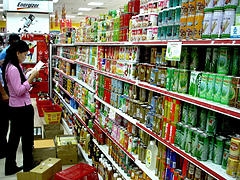
4 targets Sheng Siong is aiming for in 2013
10% retail space growth included.
According to OCBC, Sheng Siong Group (SSG) has established a set of goals for FY13: i) increase gross retail space by 10%, ii) sustain gross profit margin at current levels and iii) effect cost control initiatives to maintain operating margin.
Here's more from OCBC:
In our view, SSG should have no difficulty in achieving these targets.
i. Achievable target #1: 10% growth in gross retail space
Management has indicated a conservative 10% increase in gross retail space for FY13, which translates to a growth of 40K sf. Putting this in context, over the past ten years (FY02-FY12) the average gross retail space expansion has been 39K sf.
As such, FY13’s goal is definitely achievable. Furthermore, SSG’s FY12 expansion of 52K sf (8 stores) is only the third highest since inception of the business in 1985.
ii. Achievable target #2: gross profit margin stability
Over the course of FY12, most companies – especially those in the retailservice industry - have experienced rising labour costs related to increases in wages. This has led to pressures on operating margins, and given this climate, we deem it unlikely that price competition amongst the Big 3 supermarket chains will return as they did back in 1Q12 during the onset of the Lunar New Year celebrations.
That said, we do not anticipate significant margin improvements either. The need to balance out cost increases and maintain market share will create an implicit ceiling for gross profit margin while management’s margin enhancement initiatives (i.e. increasing direct sourcing and bulk handling) – coupled with the new warehouse management system, economies of scale afforded by its Mandai Link Distribution Centre, and proliferation of its housebrands – should help mitigate any potential increase in the cost of goods sold. Therefore, we set a reasonable projection of ~22% going forward.
iii. Achievable target #3: other cost control initiatives
To alleviate rising labour costs (i.e. related to foreign levies, increase in wages), management made changes to its salary structure. By introducing more variable pay components and associating compensation with specific sales targets, SSG is able to control its labour expenses whilst simultaneously providing a performance incentive to its employees.
iv. Macro-environment remains conducive
While we are optimistic over the retail sales outlook in Singapore, lingering doubts over the health of the global economy remain. This overhang should prove supportive for the supermarket segment as consumers exercise prudence in dining habits.
Retail spending data for the first nine months of the year have shown YoY increases in supermarket spending even though overall retail sales fell briefly in Jul. Even on a MoM basis, supermarket spending has proven more resilient versus the overall trend with bigger gains and smaller declines.
In addition, growth for SSG’s indirect competitors – food and beverage (F&B) service establishments – have remained subdued amidst tentative consumer sentiment.
























 Advertise
Advertise






